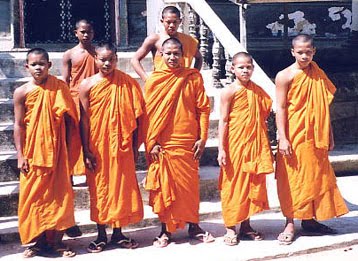Wat etiquette
 Unless you are suffering from amnesia, you'll know that I have a book coming out in the middle of this year. It's called To Cambodia With Love and will contain 125+ essays from over 60 people who have a passion for this wonderful country. As part of the process for selecting suitable essays for the book, I had to discard quite a few for various reasons, even though they contain valuable information and merit publication in one form or another. So that some of those which didn't make the final cut get some exposure, I intend to post them here, starting off with the appropriate etiquette when visiting a wat/pagoda in Cambodia by Caroline Nixon.
Unless you are suffering from amnesia, you'll know that I have a book coming out in the middle of this year. It's called To Cambodia With Love and will contain 125+ essays from over 60 people who have a passion for this wonderful country. As part of the process for selecting suitable essays for the book, I had to discard quite a few for various reasons, even though they contain valuable information and merit publication in one form or another. So that some of those which didn't make the final cut get some exposure, I intend to post them here, starting off with the appropriate etiquette when visiting a wat/pagoda in Cambodia by Caroline Nixon.What to do in a wat - by Caroline Nixon
While the Angkorian temples in Siem Reap are
Firstly, Cambodians are modest dressers and particularly so when visiting the wat. It will be appreciated if visitors wear clothes that cover their shoulders, knees and midriffs. Strappy tops, shorts and plunging necklines are not appropriate. As they enter the temple compound, Cambodians will remove their hat, and you should do likewise. It’s okay to wear your shoes as you explore the compound, but they need to removed before entering the buildings, usually just at the door, occasionally at the bottom of the steps – a little pile of shoes will usually give you a clue as to where to leave yours.
Ahead of you will be a shrine with several Buddha images. Cambodians will always keep their head lower than that of religious images or respected persons, and will lower their heads on entering the temple, then kneel in front of the images to pray. You don’t need to kneel and pray, but when you are near the shrine it will be appreciated if you sit or kneel, rather than looming above the images and worshippers. You will notice that Cambodians kneel with their feet tucked behind them. This is because pointing the foot at something or someone is considered disrespectful, so try not to point your feet at Buddha images or monks.
The majority of the monks you meet at wats will be novices, there for a short period, often to get an education. You may also meet some more senior monks. Usually they will be keen to practice their English and explain the stories depicted in the paintings on the temple walls. Women should remember that monks are not allowed any physical contact with them. Unlike in many other southeast asian countries, in
You will be welcome to wander around and look at the wall paintings and images, and to take photos, though it is polite to ask. Younger monks will be happy to pose for photos, but more senior ones may prefer not to, or will wish you to wait while they arrange their robes correctly and strike a dignified pose before you snap. Cambodians are far too polite to call attention to inappropriate behaviour, but your visit will be more welcome if you are sensitive to these customs.
FactFile: There are wats to be found all over 
Labels: Caroline Nixon, To Cambodia With Love

